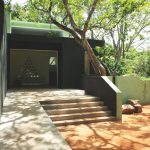The five projects selected for the 2010 Aga Khan Award for Architecture were announced at a ceremony held at the Museum of Islamic Art recently. Sheikh Hamad bin Khalifa Al Thani the Emir of Qatar and Sheikha Moza bint Nasser joined the Aga Khan in presiding over the ceremony. The five projects selected by the 2010 Master Jury are:
1. Wadi Hanifa Wetlands, Riyadh, Saudi Arabia

Located in the middle of the Najd Plateau of the Kingdom of Saudi Arabia, the Wadi Hanifa (or Hanifa valley) is the longest and most important valley near Riyadh, a natural water drainage course for an area of over 4,000 square kilometres and a unique geographical feature in this dry region. The Arriyadh Development Authority has implemented a comprehensive development strategy, that aims to restore and develop Wadi Hanifa as an environmental, recreational and tourism resource. Project work so far have included the introduction of landscaping, conservation of the natural environment, development of recreational areas for the people of Riyadh, enhancement of agricultural land in the valley, and the creation of an environmentally sensitive wastewater treatment facility.
2. Revitalisation of the Hypercentre of Tunis, Tunisia
 The 19th and early 20th Century architectural heritage of North African cities embody an important cultural exchange between the southern and northern Mediterranean. This heritage commonly lies adjacent to the old medinas. The Ville Nouvelle of Tunis, which was built when Tunisia was a French Protectorate, reflected a move from the urban patterns of the old medina to a grid plan that changed the character of the city. The urban revitalisation plan, devised and spearheaded by the Association de Sauvegarde de la Médina de Tunis (ASM), has restructured the public spaces of the area around Avenue Bourguiba and Avenue de France and made them chiefly pedestrian. It has also listed and restored key monuments, such as the Théâtre municipal de Tunis, Marché central, Ancien Tribunal administratif and Cinéma Palace, which are once again in use. The ASM continues to actively guide institutions and individuals in order to ensure overall quality.
The 19th and early 20th Century architectural heritage of North African cities embody an important cultural exchange between the southern and northern Mediterranean. This heritage commonly lies adjacent to the old medinas. The Ville Nouvelle of Tunis, which was built when Tunisia was a French Protectorate, reflected a move from the urban patterns of the old medina to a grid plan that changed the character of the city. The urban revitalisation plan, devised and spearheaded by the Association de Sauvegarde de la Médina de Tunis (ASM), has restructured the public spaces of the area around Avenue Bourguiba and Avenue de France and made them chiefly pedestrian. It has also listed and restored key monuments, such as the Théâtre municipal de Tunis, Marché central, Ancien Tribunal administratif and Cinéma Palace, which are once again in use. The ASM continues to actively guide institutions and individuals in order to ensure overall quality.
3. Madinat Al-Zahra Museum, Cordoba, Spain

The 10th Century palace city of Madinat al-Zahra is widely considered to be one of the most significant early Islamic archaeological sites in the world, and the most extensive in Western Europe. Excavations at the site are still ongoing. The museum was conceived as a place to interpret the site and display the archaeological findings, as well as to serve as a training and research centre and the headquarters of the archaeological team. A refined and subtle design by the architectural firm Nieto Sobejano, the museum complex blends seamlessly into the site and the surrounding farmland which seems more like a landscape than a building. The architects took the ground plans of three excavated buildings as a starting point. Visitors are guided through a sequence of covered spaces and voids. The main public functions are arranged in a cloister around a broad patio, a form found at the archaeological site and in the old town of Cordoba.
4. Ipekyol Textile Factory, Edirne, Turkey

The Ipekyol factory, a custom-designed facility for a manufacturer of high-quality textiles, represents a successful collaboration between a client and an architect in developing a spatial strategy that integrates production goals with the well-being of employees. Key design objectives focused on a single U-shaped volume that makes full use of the site. The architect responded with a single, large structure where administration and production spaces were integrated under one roof, breaking down hierarchies between front and back of house functions. The form of the building conveys its function, its U-shape responding to the demands of the production line, from inception to the packaging and dispatch of the garments.
5. Bridge School, Xiashi, Fujian, China
 The “Bridge School” bridges the two parts of the small village of Xiashi that lie on either side of a small creek that runs through the village. The structure is created by two steel trusses that span the creek with the space between them housing the functions of the school. Suspended from the structure and running below it is a pedestrian bridge for the people of the village to use. Small and modern in design, with no reference to the area’s traditional building style, the school has nonetheless become the physical and spiritual centre of what was a declining village. Placed in such a way that it addresses its surroundings, the Bridge School connects the village together, providing a central, social space.
The “Bridge School” bridges the two parts of the small village of Xiashi that lie on either side of a small creek that runs through the village. The structure is created by two steel trusses that span the creek with the space between them housing the functions of the school. Suspended from the structure and running below it is a pedestrian bridge for the people of the village to use. Small and modern in design, with no reference to the area’s traditional building style, the school has nonetheless become the physical and spiritual centre of what was a declining village. Placed in such a way that it addresses its surroundings, the Bridge School connects the village together, providing a central, social space.
Compiled by Amanda Rajakaruna











